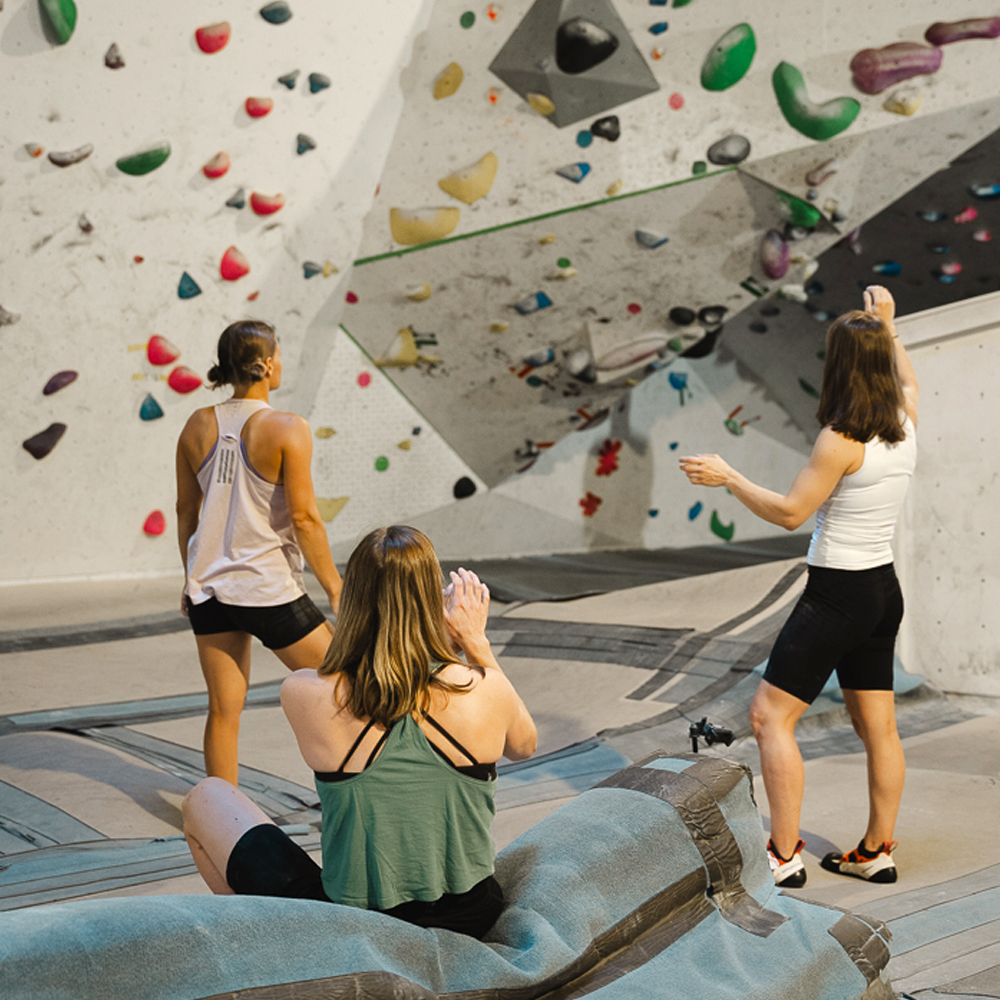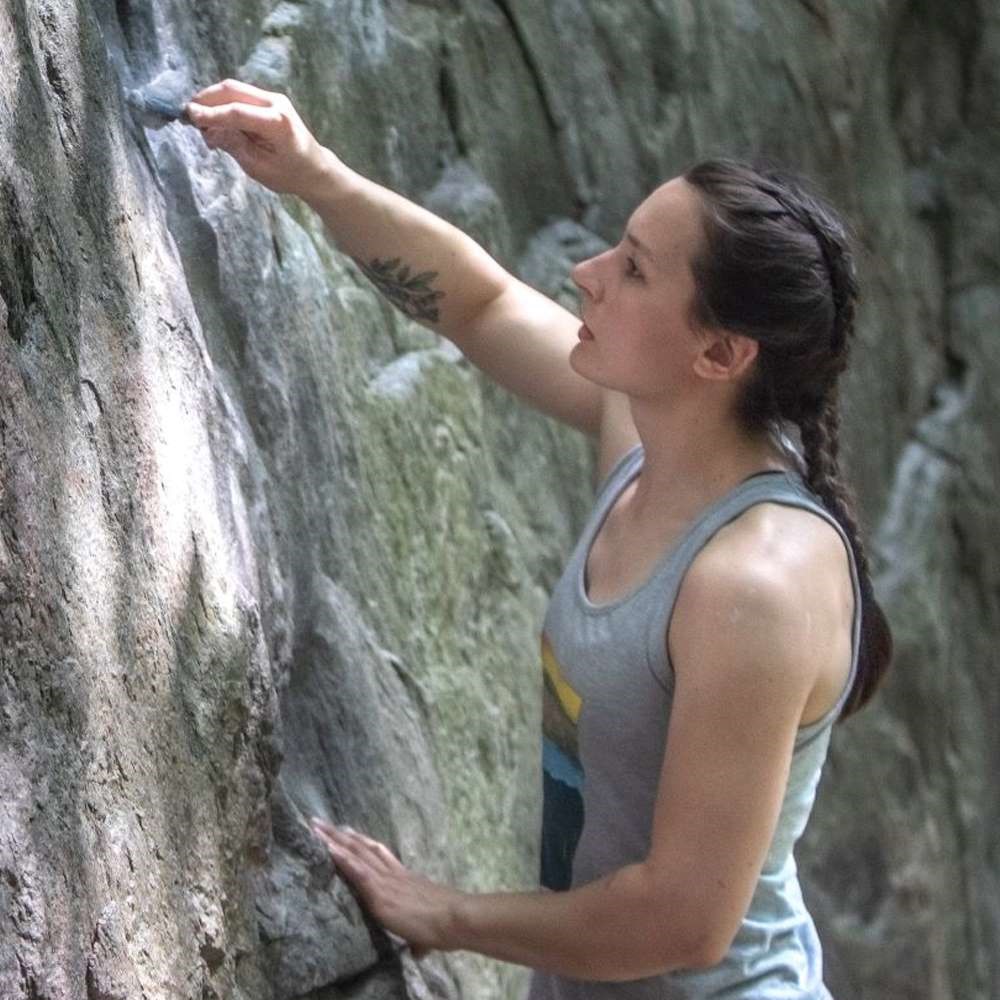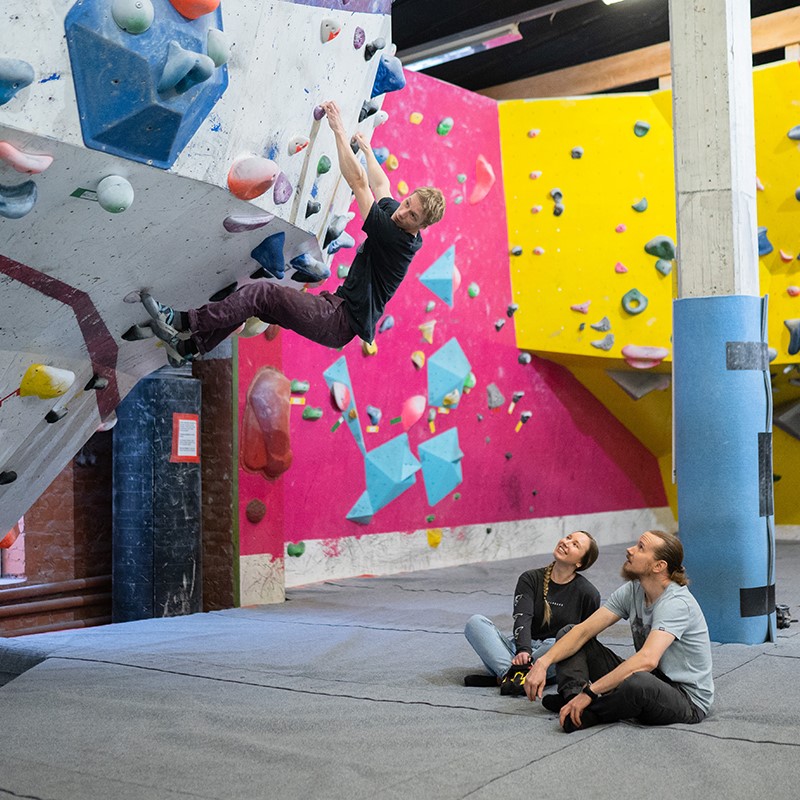As outdoor climbing, indoor climbing also has some "rules" for correctly climbing a problem. Different gyms have different grading (difficulty level) systems and different instructions in other parts too. These below apply specifically to the gyms of Boulderkeskus, but some can be generalized to indoor climbing everywhere.
- In the Boulderkeskus gyms, the difficulty level of the problem is determined by grade on the sticker next to the starting holds. One problem has single-colored holds. "Completing" a certain problem therefore requires that you only climb climbs of a certain color. There are some exceptions: sometimes competition problems or other special problems, which can have several different colors.
- The starting holds are marked for the hands and in competition climbing also for the feet with tapes. The top hold is the last hold, and for you to properly climb a problem you need to bring both hands in a controlled manner to the last hold (just a slight touch before the position fails you and you fall down does not count ;) ). You don't have to use all the holds, and if you can get to the top by dynoing, i.e. jumping directly to the top, it's just as well done as any other way.
- At Boulderkeskus, volumes, i.e. boxes, are not actual holds and therefore can be used for multiple problems. Volumes can be used for hands and feet. Today, there are some holds that are very similar to boxes in shape. If you are unsure whether it is a hold for a specific problem or a box that belongs to all problems, you can always ask the cashier for advice!
- In practice, the bolt holes of the grips can be used when climbing, if they are not blocked by a plug separately, but usually it is not appropriate - routesetters usually do not use plugs in the everyday setting, but the purpose is still that the holes would not be used for help.
- Black tape on the edge of the wall means that the edge or the wall behind it is not in use. Tape is often seen in competitions.
However, at the gym you can climb with exactly the holds you want and how you feel like - these rules mainly only apply to the correct execution of the problem. When coming down, you can always use all the holds to make your descent as safe as possible.

- If someone else has started their own problem first and that one crosses your own problem, you are obliged to give way!
- Use a brush: the more the holds are brushed, the better they stay! If you have cleaned the problem and go to get some chalk, others must wait for their turn.
Scroll down to read some more principles of good behaviour while climbing!

When climbing outside, it is especially important to brush off the chalk and tick marks when you leave the rocks, so that the boulder remains in as clean a condition as possible! Please don't use excessive amounts of chalk so that the holds stay clean.
Sometimes at the gym one has heard that brushing is only for climbers who climb harder grades or that it’s the job of the people working there. Of course, this is not true, but brushing is something everyone should do!
By brushing the holds, they stay cleaner and more usable for longer. Your project may also go easier when the excess rubber and chalk have been cleaned out of the way of friction. Brushing the fingerboards is also really advisable!
One unwritten rule reads as follows: the one who has brushed the holds has the next turn on the problem. This means that if someone at the gym or outside brushes the holds and goes to chalk up, you have to wait for your turn or at least ask first if it's okay to go or if the brusher is still going on the problem. Friendly climbers can also brush the holds for the next climber - of course then it's good to tell the fellow climber that it's okay to go despite the brushing, so that there are no misunderstandings.
When climbing in the gym or outside, taking others into account includes at least the following things:
- Take turns climbing routes or problems with fellow climbers, i.e. do not hog routes! If your training requires you to climb a certain problem multiple times with a specific schedule, you can always ask the other climbers if it would be okay for you to complete your training. However, it’s not polite to reserve a certain part of the wall or certain problems for an exceedingly long time just for your use, even if other climbers are kind enough to take your training into account.
- Pay attention to where the problem goes and ends: the climber who started to climb the problem first has the priority if your own problem intersects with theirs. Route reading is also beneficial for your climbing.
- No beta spray, please! Beta spraying means giving advice without the other asking or hoping for it. In climbing, solving the problem can be the most fun part, and therefore advice is not always welcome. Let your fellow climber think about the beta in peace and solve the beta on their own. If you have a good tip that could be helpful, you can always ask if they want to hear it!

Boulderkeskus gyms are a safe space where everyone can climb without a fear of discrimination! Take a look at our safe space principles here.

Some etiquette rules are closely related to safety, mostly about taking other climbers into consideration. There are certainly more safety tips than what we cover here but they are not so tied to climbing etiquette.
The most important rule is that it must be safe for the climber to climb and fall without anyone being below. The gyms have high and overhanging walls, from which the climber can fall very far when coming down, so a large safety distance must be left between the other climber on the mattress and the wall. The responsibility is always on the person staying on the mattress, because the climber has the right to focus on their performance. Some gyms also have tighter spaces and spots, where it is not good to stay at all. The best place to wait for your turn to climb is by the edge of the mattress.
Water bottles, backpacks or other items should also not be left on the mattresses, as falling on them is equally a risk. The long brushes intended for cleaning climbing holds also pose a danger if they are left lying on the mattress in the fall area or on the floor - you can spin your ankle when stepping off the mattress onto the brush handle. So let's put things in their places for safety.
Of course, it is the responsibility of the climber to check before starting to climb that there are no items on the mattress and that the mattress is in good condition. If the climber feels that the co-climber is too close to the fall area on the mattress, they can be kindly asked to move.
Parents and guardians of children have a great responsibility at the climbing gym. Children do not always understand the risks, so parents need to make sure that the child does not run or stay on mattresses other than when climbing. With children, it is good to go over the rules of the gym several times, even every time you come to the gym to refresh the memory.
Let’s respect everyone's climbing performance and safety!
